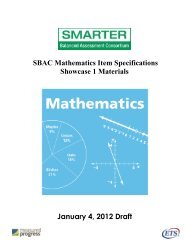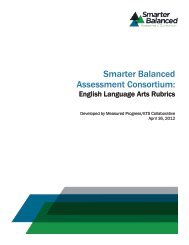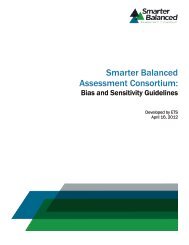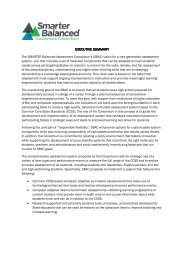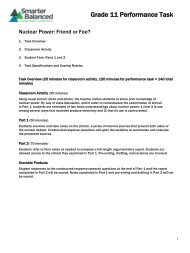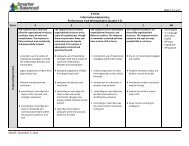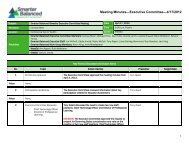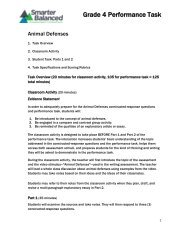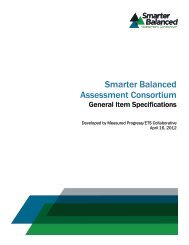Content Specifications for the Summative Assessment of the ...
Content Specifications for the Summative Assessment of the ...
Content Specifications for the Summative Assessment of the ...
Create successful ePaper yourself
Turn your PDF publications into a flip-book with our unique Google optimized e-Paper software.
How to Read and Interpret <strong>the</strong> <strong>Summative</strong> <strong>Assessment</strong> Targets Tables<br />
[Excerpt from Claim #1 – Gr. 4, Reading Literary Texts]<br />
Grade 4 SUMMATIVE ASSESSMENT TARGETS<br />
Providing Evidence Supporting Claim #1<br />
ELA/Literacy Claim #1<br />
Students can read closely and analytically to comprehend a range <strong>of</strong><br />
increasingly complex literary and in<strong>for</strong>mational texts.<br />
50% <strong>of</strong> text-related assessment evidence will come from reading literary texts, and may<br />
include stories, poems, plays, myths, or legends<br />
To <strong>the</strong> degree possible, all literary passages will include at least one item assessing each <strong>of</strong><br />
<strong>the</strong> assessment targets (#1-#4) below:<br />
SUPPORTING EVIDENCE: Cite specific<br />
textual evidence to support conclusions<br />
drawn from <strong>the</strong> text(s)<br />
Standards: RL-1<br />
(RL-1 is a component <strong>of</strong> each <strong>of</strong> <strong>the</strong> seven<br />
targets listed below.)<br />
1. KEY DETAILS: Use explicit details and<br />
implicit in<strong>for</strong>mation from <strong>the</strong> text to support<br />
answers or basic inferences<br />
Standards: RL-1, RL-3<br />
(DOK 1, DOK 2)<br />
RL-1 Refer to details and examples in a text when explaining what<br />
<strong>the</strong> text says explicitly and when drawing inferences from <strong>the</strong> text.<br />
RL-1 Refer to details and examples in a text when explaining what<br />
<strong>the</strong> text says explicitly and when drawing inferences from <strong>the</strong> text.<br />
RL-3 Describe in depth a character, setting, or event in a story or<br />
drama, drawing on specific details in <strong>the</strong> text (e.g., a character’s<br />
thoughts, words, or actions).<br />
Grade and<br />
Claim #<br />
shown<br />
Text <strong>of</strong><br />
Claim is<br />
General<br />
conditions,<br />
emphasis, or<br />
assessment<br />
constraints<br />
on what is<br />
presented to<br />
students are<br />
shown here<br />
2. CENTRAL IDEAS: Identify or<br />
summarize central ideas/ key events<br />
Standards: RL-2 (DOK 1, DOK 2)<br />
3. WORD MEANINGS: Determine<br />
intended meanings <strong>of</strong> words, including<br />
words with multiple meanings<br />
(academic/tier 2 words), based on context,<br />
word relationships (e.g., synonyms), word<br />
structure (e.g., common Greek or Latin<br />
roots, affixes), or use <strong>of</strong> resources (e.g.,<br />
dictionary, <strong>the</strong>saurus)<br />
Standards: RL-4; L-4, L-5c<br />
(DOK 1, DOK 2)<br />
Targets are<br />
Depth <strong>of</strong> knowledge<br />
mapped to<br />
level(s) intended <strong>for</strong><br />
standards or<br />
each target 4. are REASONING & EVIDENCE: objectives from Use<br />
supporting evidence to CCSS justify/ explain<br />
inferences (character development<br />
/actions/traits; first or third person point <strong>of</strong><br />
view; <strong>the</strong>me; author’s message)<br />
Standards: RL-2, RL-3, RL-6 (DOK 3,<br />
DOK 4 4 )<br />
RL-2 Determine a <strong>the</strong>me <strong>of</strong> a story, drama, or poem from details in<br />
<strong>the</strong> text; summarize <strong>the</strong> text.<br />
RL-4 Determine <strong>the</strong> meaning <strong>of</strong> words and phrases as <strong>the</strong>y are<br />
used in a text, including those that allude to significant characters<br />
found in mythology (e.g., Herculean).<br />
L-4 Determine or clarify <strong>the</strong> meaning <strong>of</strong> unknown and multiplemeaning<br />
words and phrases based on grade 4 reading and content,<br />
choosing flexibly from a range <strong>of</strong> strategies.<br />
a. Use context (e.g., definitions, examples, or restatements in text) as<br />
a clue to <strong>the</strong> meaning <strong>of</strong> a word or phrase.<br />
b. Use common, grade‐appropriate Greek and<br />
Latin affixes and roots as clues to <strong>the</strong> meaning <strong>of</strong> a word (e.g.,<br />
telegraph, photograph, autograph).<br />
c. Consult reference materials (e.g., dictionaries, glossaries,<br />
<strong>the</strong>sauruses), both print and digital, to find <strong>the</strong> pronunciation and<br />
determine or clarify <strong>the</strong> precise meaning <strong>of</strong> key words and phrases.<br />
L-5c Demonstrate understanding <strong>of</strong> words by relating <strong>the</strong>m to<br />
<strong>the</strong>ir opposites (antonyms) and to words with similar but not<br />
identical meanings (synonyms).<br />
RL-2 Determine a <strong>the</strong>me <strong>of</strong> a story, drama, or poem from details in<br />
<strong>the</strong> text; summarize <strong>the</strong> text.<br />
RL-3 Describe in depth a character, setting, or event in a story or<br />
drama, drawing on specific details in <strong>the</strong> text (e.g., a character’s<br />
thoughts, words, or actions).<br />
RL-6 5 Compare and contrast <strong>the</strong> point <strong>of</strong> view from which<br />
different stories are narrated, including <strong>the</strong> difference between first‐<br />
Underlined<br />
standards<br />
require <strong>the</strong><br />
use <strong>of</strong> more<br />
than one text<br />
Proposed Reporting Categories: For each claim a set <strong>of</strong> “Potential Reporting Categories” follows <strong>the</strong><br />
4 In many cases, but NOT ALL, when students analyze deeply and draw in<strong>for</strong>mation from multiple (full) texts <strong>for</strong> supporting evidence, <strong>the</strong> DOK level<br />
becomes level 4, whereas <strong>the</strong> same task using a single text (or shorter excerpts) would be DOK level 3.<br />
5 CC Standards that are underlined indicate that more than one text or more than one text <strong>for</strong>mat is required <strong>for</strong> assessment items.<br />
24



